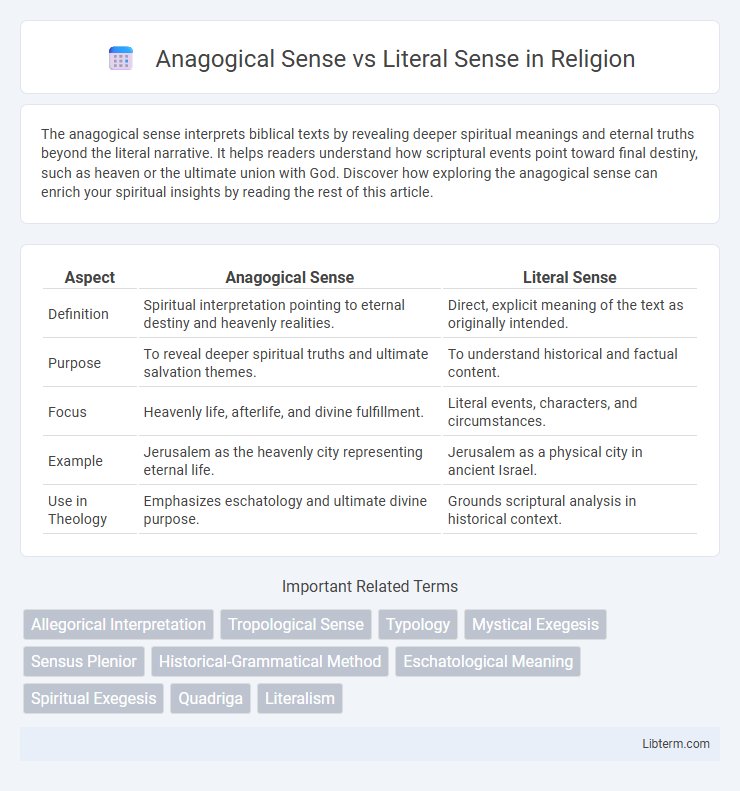The anagogical sense interprets biblical texts by revealing deeper spiritual meanings and eternal truths beyond the literal narrative. It helps readers understand how scriptural events point toward final destiny, such as heaven or the ultimate union with God. Discover how exploring the anagogical sense can enrich your spiritual insights by reading the rest of this article.
Table of Comparison
| Aspect | Anagogical Sense | Literal Sense |
|---|---|---|
| Definition | Spiritual interpretation pointing to eternal destiny and heavenly realities. | Direct, explicit meaning of the text as originally intended. |
| Purpose | To reveal deeper spiritual truths and ultimate salvation themes. | To understand historical and factual content. |
| Focus | Heavenly life, afterlife, and divine fulfillment. | Literal events, characters, and circumstances. |
| Example | Jerusalem as the heavenly city representing eternal life. | Jerusalem as a physical city in ancient Israel. |
| Use in Theology | Emphasizes eschatology and ultimate divine purpose. | Grounds scriptural analysis in historical context. |
Understanding Anagogical and Literal Senses
The anagogical sense interprets biblical texts by revealing spiritual or mystical meanings related to salvation and the afterlife, transcending the immediate literal context. The literal sense focuses on the explicit meaning of the words as originally intended by the author, providing the foundational understanding of scripture. Recognizing the distinction between anagogical and literal senses enhances theological study by bridging concrete historical facts with deeper spiritual insights.
Defining the Literal Sense in Interpretation
The literal sense in interpretation refers to understanding the text based on the explicit meaning of the words and phrases as intended by the original author, grounded in historical and cultural context. It focuses on what the text directly communicates without allegory or symbolism, serving as the foundation for all other senses of meaning. This approach ensures clarity by anchoring interpretation in concrete details before exploring anagogical or spiritual dimensions.
Exploring the Anagogical Sense: A Deeper Meaning
The anagogical sense reveals deeper spiritual truths by interpreting biblical narratives as symbols of ultimate divine realities, transcending the literal sense's focus on historical or factual content. This interpretative layer invites believers to contemplate eternal life, heaven, and the soul's journey, enriching theological understanding and personal faith. The anagogical sense fosters a multi-dimensional reading of scripture, encouraging a profound connection with transcendent meanings beyond the surface narrative.
Historical Roots of Biblical Exegesis
The anagogical sense and the literal sense represent two fundamental approaches in the historical roots of biblical exegesis, where the literal sense seeks to understand the text's explicit meaning tied to its original context and language, while the anagogical sense interprets scripture in relation to ultimate spiritual realities and eternal truths. Early Church Fathers like Augustine and Origen established these interpretive frameworks to explore layers of meaning beyond the surface narrative. This duality of senses reflects the medieval quadriga method, which enriched scriptural study by combining historical context with theological prophecy and eschatological hope.
Key Differences: Anagogical vs Literal Sense
The anagogical sense interprets biblical texts by revealing spiritual or mystical meanings related to eternal life and the afterlife, while the literal sense focuses on the direct, historical, and grammatical meaning of the text. The literal sense prioritizes understanding words as they were originally intended by the human author, often emphasizing factual and contextual accuracy. In contrast, the anagogical sense seeks deeper, symbolic insights that guide believers towards divine truths and ultimate realities beyond the immediate narrative.
Importance of Context in Scriptural Analysis
Understanding the anagogical sense versus the literal sense in scriptural analysis hinges on the importance of context, as the literal sense conveys the explicit meaning of the text based on historical and grammatical factors. The anagogical sense reveals deeper spiritual or eschatological truths, often requiring familiarity with theological doctrines and symbolic interpretations rooted in the broader biblical narrative. Accurate exegesis depends on discerning these layers within their contextual framework, ensuring that interpretations respect both the original intent and the spiritual significance conveyed through scripture.
Examples of Literal Sense in Sacred Texts
The literal sense in sacred texts refers to the direct, straightforward meaning conveyed by the words, such as the creation account in Genesis describing God forming the heavens and earth in six days. In the parable of the Good Samaritan in Luke, the literal sense presents a story about a man helping a stranger attacked by robbers. The Ten Commandments in Exodus provide explicit moral laws that exemplify the literal meaning without symbolic interpretation.
Illustrations of Anagogical Sense in Practice
Anagogical sense interprets biblical texts by revealing spiritual or mystical meanings that point toward eternal life and divine realities, contrasting with the literal sense which focuses on the explicit, historical meaning of the text. Illustrations of the anagogical sense include interpreting the crossing of the Red Sea as a symbol of baptism and spiritual liberation, or viewing the New Jerusalem described in Revelation as a representation of the ultimate heavenly fulfillment and eternal union with God. These examples demonstrate how the anagogical perspective transcends the immediate narrative to express deeper eschatological truths.
Relevance of Both Senses in Modern Theology
The anagogical sense reveals spiritual or eschatological meanings within biblical texts, guiding believers toward understanding divine mysteries and eternal truths. The literal sense grounds scriptural interpretation in historical and grammatical context, ensuring accurate comprehension of the original message. Modern theology values both senses to balance faithful tradition with contemporary application, enriching doctrinal insights and fostering deeper spiritual engagement.
Integrating Literal and Anagogical Insights
Integrating literal and anagogical insights enhances biblical interpretation by combining the straightforward, historical meaning of the text with its deeper, spiritual significance related to ultimate destiny or divine truths. This approach allows readers to grasp both the immediate context and the transcendent purpose, enriching theological reflection and personal faith. Emphasizing this integration supports a holistic understanding that bridges earthly realities and eternal implications.
Anagogical Sense Infographic

 libterm.com
libterm.com